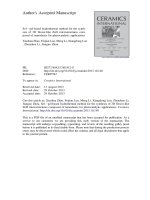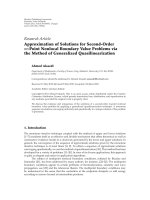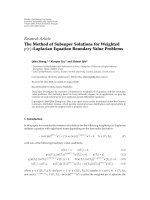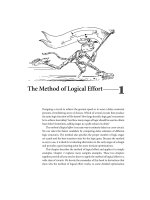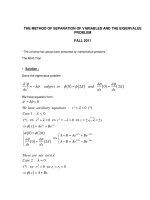THE METHOD OF SEPARATION OF VARIABLES
Bạn đang xem bản rút gọn của tài liệu. Xem và tải ngay bản đầy đủ của tài liệu tại đây (64.81 KB, 8 trang )
THE METHOD OF SEPARATION OF VARIABLES AND THE EIGENVALUE
PROBLEM
FALL 2011
“ The universe has always been presented by mathematical problems “
The Minh Tran
1. Solution :
Solve the eigenvalue problem :
( ) ( ) ( ) ( )
2
2
0 2 0 2
d d d
subject to and
dx dx
dx
φ φ φ
λφ φ φ π π
= − = =
We have equation form :
( )
( ) ( )
( ) ( )
"
2
2 2
2 2
2 2
0
: 0 (*)
1 : 0
(*) 0 0
0 2
0 2
sx sx
s s
s s
We have auxiliary equations r
Case
r r r s
x Ae Be
A B Ae Be
d d
A B Ae Be
dx dx
There are not exist
π π
π π
φ λφ
λ
λ
λ λ λ
φ
φ φ π
φ φ
π
λ
−
−
−
+ =
+ =
<
⇔ + = ⇔ = − > ⇔ = ± − = ±
⇒ = +
=
+ = +
⇔
= − = −
( )
2
1 2
2 : 0
(*) 0 0
Case
r r r
x A Bx
λ
φ
=
⇔ = ⇔ = =
⇒ = +
(
)
(
)
( ) ( )
( )
0 2
2
0 2
0
A A B
d d
B B
dx dx
B
x A
A
φ φ π
π
φ φ
π
φ
=
= +
⇔
=
=
=
⇔ ⇒ =
∀
We have not had eigenvalue
( )
( ) ( )
( ) ( )
( )
( )
( )
2 2
2 2
2 2
2
3 : 0
(*) 0 0
cos sin
0 2
cos 2 sin 2
0 2
sin 2 cos 2
2 1 0
2 1 ( 0)
2 2
Case
r r r i
x A x B x
A A B
d d
B A B
dx dx
A B Cos
Cos Because A B
n n n
λ
λ λ λ
φ λ λ
φ φ π
π λ π λ
φ φ
π
π λ π λ
π λ
π λ
π λ π λ
>
⇔ + = ⇔ = − < ⇒ = ±
⇒ = +
=
= +
⇔
=
= − −
⇔ + − =
⇔ − + ≠
⇔ = ∈ ⇒ =
»
2. Explicitly show there are no negative eigenvalues for
( ) ( )
2
2
0 0 , 0
d d d
subject to L
dx dx
dx
φ φ φ
λφ
= − = =
Solution :
We have equation form :
( )
( )
( )
"
2
2 2
0
: 0 (*)
: 0
0 0
0 0
0
2 0
,
sx sx
We have auxiliary equations r
When
r r r s
x Ae Be
d
dx
d
dx
Thus there are no negative eigenvalues
φ λφ
λ
λ
λ λ λ
φ
φ
λ
φ
π
−
+ =
+ =
<
⇔ + = ⇔ = − > ⇔ = ± − = ±
⇒ = +
=
⇔ =
=
3. Solve the heat equation :
( ) ( )
2
2
, 0 , 0
0, 0 0 , , 0 0
u u
x L t subject to
t
x
u u
t t L t t
x x
∂ ∂
= < < >
∂
∂
∂ ∂
= > = >
∂ ∂
Solution :
( )
3
) ,0 6 4cos
x
a u x
L
π
= +
We have infinite series solution
( )
2 2
2
1
, cos
kn t
L
n
n
n x
u x t A e
L
π
π
∞
−
=
=
∑
So
( )
1
0
0
0
0
3
0
3
6 4cos ,0 cos 0
2 3
6 4cos cos
1 3
6 4cos
6
2 3 3
6 4cos cos 4
0
n
n
L
n
L
L
x n x
u x A with t
L L
x n x
A dx
L L L
x
A dx
L L
A
x x
A dx
L L L
Others
π π
π π
π
π π
∞
=
+ = = =
⇒ = +
⇒ = +
⇒ =
⇒ = + =
=
∑
∫
∫
∫
( )
8
) ,0 3cos
x
b u x
L
π
= −
We have infinite series solution
( )
2 2
2
1
, cos
kn t
L
n
n
n x
u x t A e
L
π
π
∞
−
=
=
∑
So
( )
1
0
0
0
0
8
0
8
0
8
3cos ,0 cos
6 8
cos .cos
1 8
cos
0
6 8 8
cos .cos
3 16
(1 cos .) 3
0
n
n
L
n
L
L
L
x n x
u x A
L L
x n x
A dx
L L L
x
A dx
L L
A
x x
A dx
L L L
x
A dx
L L
Others
π π
π π
π
π π
π
∞
=
− = =
⇒ = −
⇒ =
⇒ =
⇒ = −
= = − + = −
=
∑
∫
∫
∫
∫
( )
) ,0 2sin
x
c u x
L
π
= −
We have infinite series solution
( )
2 2
2
1
, cos
kn t
L
n
n
n x
u x t A e
L
π
π
∞
−
=
=
∑
So
( )
1
0
0
0
2sin ,0 cos
4
sin .cos
1 4
2sin .
n
n
L
n
L
x n x
u x A
L L
x n x
A dx
L L L
x
A
L L
π π
π π
π
π
∞
=
− = =
⇒ = −
⇒ = − = −
∑
∫
∫
4. For the following PDEs, what ODEs are implied by the method of
separation of variables ?
Solution :
We can use the method of separation of variables to find the following ODEs
( ) ( )
( ) ( )
( )
( )
4
4
4 4
4
)
( , )
( , )
u u
a
t
x
From the equation u x t x G t
where x is only a function of x and G t is a function of t
We will get first partial derivetive of u x t with
respect to t and the fourth
partial derivative with respect to x
dG t
u
x
t dt
u d
x
φ
φ
φ
∂ ∂
=
∂
∂
=
∂
=
∂
∂
=
∂
( )
( )
4
4
4
( )
( ) (1)
G t
dx
dG t
d
x G t
dt
dx
φ
φ
φ
⇒ =
(
)
( )
4
4
var (1) ( )
1 1
We can separate iableby dividing both sides of b
y x G t
dG t
d
G dt
dx
φ
φ
φ
=
We can give the both sides equal the same constant
(
)
( )
4
4
4
4
1 1
, , ( ) ( )
dG t
d
where is an arbitrary constant
G dt dx
Thus we have ODEs one for G t and one for x
dG t
G
dt
d
dx
φ
λ λ
φ
φ
λ
φ
λφ
= = −
= −
= −
( ) ( )
( ) ( )
( )
( )
2 2
2
2 2
2
2
2 2
)
( , )
sec ( , ) sec
u u
b c
t x
From the equation u x t x G t
where x is only a function of x and G t is a function of t
We will get ond partial derivetive of u x t with re
spect to t and the ond
partial derivative with respect to x
d G t
u
x
t d t
φ
φ
φ
∂ ∂
=
∂ ∂
=
∂
=
∂
( )
( )
2 2
2 2
2
2
2
2 2
( )
( ) (1)
u d
G t
x dx
d G t
d
x c G t
d t dx
φ
φ
φ
∂
=
∂
⇒ =
(
)
( )
2
2
2
2 2
var (1) ( )
1 1
We can separate iableby dividing both sides of b
y x G t
d G t
d
c
G
d t dx
φ
φ
φ
=
We can give the both sides equal the same constant
(
)
( )
2
2
2
2 2
2
2
2
2
2
1 1
, , ( ) ( )
d G t
d
c where is an arbitrary constant
G
d t dx
Thus we have ODEs one for G t and one for x
d G t
G
d t
d
c
dx
φ
λ λ
φ
φ
λ
φ
λφ
= = −
= −
= −
( ) ( )
( ) ( )
)
var ,
( , )
( , )
u k u
c r
t r r r
Inthe method of separation of iables we will fin
d solutions in the product form
u r t r G t
where r is only a function of r and G t is a function of t
We will get the first partial derivetive of u r t with respec
φ
φ
∂ ∂ ∂
=
∂ ∂ ∂
=
( )
( )
( )
( )
( ) ( )
sec
(1)
t to t and the ond
partial derivative with respect to r
dG t
u
r
t dt
u d d
r G t r
r r dr dr
dG t kG t
d d
r r
dt r dr dr
φ
φ
φ
φ
∂
=
∂
∂ ∂
=
∂ ∂
⇒ =
(
)
( )
var (1) ( )
1 1
We can separate iableby dividing both sides of b
y k r G t
dG t
d d
r
kG dt r dr dr
φ
φ
φ
=
We can give the both sides equal the same constant
(
)
1 1
dG t
d d
r where is an arbitrary constant
kG dt r dr dr
φ
λ λ
φ
= = −
( )
, , ( ) ( )
Thus we have ODEs one for G t and one for r
dG t
kG
dt
d d
r r
dr dr
φ
λ
φ
λφ
= −
= −




